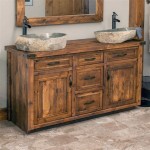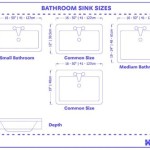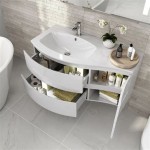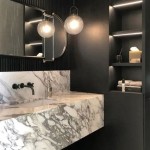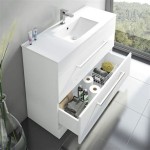Bathroom Vanity Top With Left Offset Sink: A Comprehensive Guide
A bathroom vanity top with a left offset sink presents a functional and aesthetic solution for bathroom design, offering unique advantages over centered or right-offset configurations. This design choice can significantly impact the usability of the vanity, available countertop space, and the overall visual appeal of the bathroom. Understanding the nuances of this configuration is key to making informed decisions during a bathroom renovation or new construction project.
The term "offset sink" refers to a sink basin that is not centered on the vanity top. A left offset sink, specifically, is positioned towards the left side of the vanity, as viewed when facing the vanity directly. This placement creates a larger, more usable expanse of countertop space on the right side. This configuration is particularly beneficial in smaller bathrooms where maximizing usable space is paramount, as well as in larger bathrooms where a dedicated workspace beside the sink is desired.
Choosing a bathroom vanity top with a left offset sink involves considering several factors, including the size and layout of the bathroom, the intended use of the vanity, the style preferences of the homeowner, and the practical considerations of plumbing installation. This article will explore the key points involved in selecting and installing a left offset sink vanity top, providing a comprehensive overview of the design considerations, material options, and installation guidelines.
Understanding the Benefits of a Left Offset Sink
The primary advantage of a left offset sink lies in the increased countertop space it provides. This extra space can be invaluable for a variety of reasons. Homeowners can utilize it for storing toiletries, applying makeup, or simply having a convenient surface for placing everyday items like toothbrushes, soap dispensers, and grooming tools. In bathrooms with limited square footage, this extra space can significantly enhance functionality and reduce clutter.
Furthermore, a left offset sink can be advantageous for individuals who are right-handed. The larger workspace on the right allows for easier access to items and tools used with the dominant hand. While this is not a universal preference, it can be a significant factor for some users. Conversely, those who are left-handed might prefer a right offset sink for similar reasons. In shared bathrooms, considering the dominant hand of the primary user can influence the optimal sink placement.
From a design perspective, a left offset sink can create visual interest and asymmetry in a bathroom that might otherwise feel too symmetrical or rigid. The off-center placement draws the eye and can be used to highlight other design elements in the room. It can also create a more modern and contemporary aesthetic compared to a traditional centered sink configuration. The offset sink design allows for more creative freedom with accessories and décor placement on the vanity top.
Key Considerations When Choosing a Vanity Top Material
The material chosen for the vanity top is a crucial decision that will impact both the aesthetics and the durability of the vanity. Several material options are available, each with its own set of advantages and disadvantages. Some of the most popular choices include granite, quartz, marble, solid surface, and laminate.
Granite is a natural stone known for its durability and unique patterns. It is heat resistant and relatively scratch resistant, making it a good choice for a bathroom vanity top. However, granite is porous and requires regular sealing to prevent staining. It can also be more expensive than other options.
Quartz is an engineered stone that offers excellent durability and resistance to stains, scratches, and heat. It is non-porous and does not require sealing. Quartz is available in a wide range of colors and patterns, making it a versatile option for many bathroom styles. While typically more expensive than laminate or solid surface, it is often considered a more cost-effective alternative to natural stone like granite or marble.
Marble is a luxurious natural stone that adds elegance and sophistication to any bathroom. It is known for its veining and distinctive appearance. However, marble is a softer stone than granite or quartz and is more susceptible to scratches and staining. It requires careful maintenance and sealing to preserve its beauty.
Solid surface materials, such as Corian, are non-porous, seamless, and repairable. They are resistant to stains and mildew, making them a practical choice for bathrooms. Solid surface is available in a variety of colors and textures and can be molded into different shapes. However, solid surface can be more prone to scratching than granite or quartz.
Laminate is a cost-effective option that offers a wide range of colors and patterns. It is relatively easy to clean and maintain. However, laminate is less durable than other materials and is susceptible to scratching, chipping, and water damage. It is not heat resistant and can be damaged by hot objects. Laminate is best suited for bathrooms with light to moderate use.
The choice of material should be based on a balance of aesthetic preferences, budget constraints, and durability requirements. Consider the frequency of use, the likelihood of spills or stains, and the desired level of maintenance when making a decision.
Installation Guidelines for a Left Offset Sink Vanity Top
Proper installation of a left offset sink vanity top is essential to ensure its stability, functionality, and longevity. While professional installation is recommended, homeowners with adequate DIY skills can successfully install a vanity top themselves. It is important to carefully follow the manufacturer’s instructions and adhere to local building codes.
Before beginning the installation process, ensure that all necessary tools and materials are available, including a level, measuring tape, drill, screwdriver, sealant, and appropriate fasteners. The vanity cabinet must be level and securely mounted to the wall before installing the countertop. Check the level both horizontally and vertically to ensure a stable base.
Carefully measure the dimensions of the vanity cabinet to ensure a proper fit for the countertop. Dry-fit the countertop to the cabinet before applying any sealant or adhesives. Check for any gaps or inconsistencies and make any necessary adjustments. If the countertop needs to be cut to size, use the appropriate tools and techniques to achieve a clean and precise cut.
Apply a bead of sealant along the top edge of the vanity cabinet where the countertop will rest. This sealant will help to create a waterproof barrier and prevent moisture from seeping into the cabinet. Carefully position the countertop onto the cabinet, ensuring that it is aligned properly. Press down firmly to ensure good contact with the sealant.
Secure the countertop to the vanity cabinet using appropriate fasteners, such as screws or adhesive. Follow the manufacturer’s instructions for fastener placement and tightening torque. Avoid over-tightening the fasteners, as this can damage the countertop or cabinet. Once the countertop is securely attached, allow the sealant to cure completely before installing the sink and faucet.
Install the sink according to the manufacturer’s instructions. Apply a bead of sealant around the rim of the sink where it will contact the countertop. Carefully position the sink into the opening and secure it with the provided hardware. Wipe away any excess sealant. Connect the plumbing according to local codes, ensuring that all connections are tight and leak-free.
Finally, install the faucet and any other desired accessories, such as a soap dispenser or backsplash. Test the sink and faucet to ensure that they are functioning properly. Check for any leaks and make any necessary adjustments. Clean the countertop and surrounding area to remove any debris or fingerprints.
By following these installation guidelines, homeowners can successfully install a left offset sink vanity top and enjoy its functionality and aesthetic appeal for years to come. Professional installation is always an option for those who are not comfortable with DIY projects or who want to ensure a flawless installation.
In conclusion, a bathroom vanity top with a left offset sink is a versatile and practical choice for a variety of bathroom designs. By carefully considering the benefits, material options, and installation guidelines outlined in this article, homeowners can make informed decisions and create a bathroom that is both functional and aesthetically pleasing.

Pronto Vanity Carrara White 22 X 37 Top Left Offset Cabinets To Go

Bellaterra Home 43 X 22 White Quartz Three Hole Vanity Top With Left Us Bath

Ariel Cambridge Espresso 37 In Left Offset Single Sink Bathroom Vanity With Carrera White Natural Marble Top Lowe S

Blu Bathworks Sa1401 01g 1400 Integrated 6 75 H X 55 25 W 20 D Vanity Top And Offset Left Basin In White Gloss Af Supply

Left Offset Bathroom Vanity Vanities Without Tops Small

Ariel Cambridge Grey 43 In Left Offset Single Sink Bathroom Vanity With Carrera White Natural Marble Top A043slcwrvogry Rona

Pronto Vanity White 22 X 37 Top Left Offset Cabinets To Go

The Marble Factory Bathroom Vanity Top Left Hand Sink 49 In X 22 White Engineered Réno Dépôt

Ariel Cambridge 37 In Espresso Left Offset Single Sink Bathroom Vanity With Carrera White Natural Marble Top Rona

Bathroom Vanities With Offset Sinks A Simple Way To Avoid Big Renovation
Related Posts
